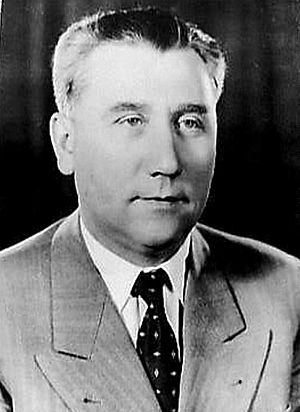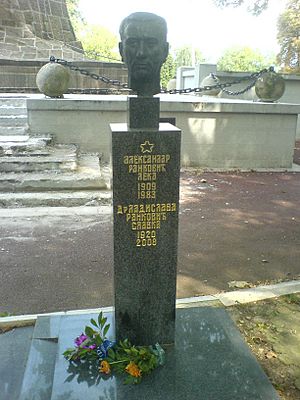Aleksandar Ranković facts for kids
Quick facts for kids
Aleksandar Ranković
|
|
|---|---|
|
Александар Ранковић
|
|
 |
|
| 1st Vice President of Yugoslavia | |
| In office 30 June 1963 – 1 July 1966 |
|
| President | Josip Broz Tito |
| Preceded by | Position established |
| Succeeded by | Koča Popović |
| Deputy Prime Minister of Yugoslavia | |
| In office 1 April 1949 – 18 April 1963 |
|
| Prime Minister | Josip Broz Tito |
| Preceded by | Jaša Prodanović |
| Succeeded by | Svetislav Stefanović |
| Minister of the Interior | |
| In office 2 February 1946 – 14 January 1953 |
|
| Prime Minister | Josip Broz Tito |
| Preceded by | Vlada Zečević |
| Succeeded by | Svetislav Stefanović |
| Chief of OZNA | |
| In office 13 May 1944 – March 1946 |
|
| Vice President of the People's Assembly of Serbia | |
| In office November 1944 – January 1946 |
|
| Personal details | |
| Born | 28 November 1909 Draževac, Kingdom of Serbia |
| Died | 19 August 1983 (aged 73) Dubrovnik, SR Croatia, SFR Yugoslavia |
| Cause of death | Heart attack |
| Resting place | New Cemetery, Belgrade, Serbia |
| Political party | Communist Party of Yugoslavia (1928–1966) |
| Spouses |
Anđa Jovanović
(m. 1935; Slavka Becele
(m. 1946) |
| Children | 2 |
| Occupation | Politician, soldier, worker |
| Awards | Order of the People's Hero Order of the Hero of Socialist Labour Order of National Liberation |
| Nicknames | Leka, Marko |
| Military service | |
| Allegiance | |
| Branch/service | Yugoslav Partisans |
| Years of service | 1941–1945 |
| Rank | Colonel general |
| Battles/wars | World War II in Yugoslavia |
Aleksandar Ranković (born 28 November 1909 – died 19 August 1983) was a very important politician in Yugoslavia. He was a leading member of the Communist Party of Yugoslavia. Many people thought he was the third most powerful person in the country. This was after Josip Broz Tito and Edvard Kardelj.
Ranković believed Yugoslavia should be a strong, united country. He did not like ideas that would split power among different regions. He wanted Serbs to have a strong role in places like Kosovo. He was also worried about groups in Kosovo who wanted to separate.
When he died in 1983, many people came to his funeral. They saw him as a leader for the Serbian people. Some even think his ideas influenced later politicians like Slobodan Milošević.
Contents
Early Life and Joining the Movement
Ranković was born in a small village called Draževac in Serbia. His family was poor, and he lost his father when he was young. He finished primary school in his village.
Later, he moved to Belgrade to find work. There, he joined a group of workers. He also learned about communist ideas from his friends. These ideas were popular even though the Communist Party was banned. At 15, he joined a union. In 1928, he became a member of the Communist Party of Yugoslavia. Soon after, he became a leader for the Communist Youth group in Belgrade.
Time Before World War II
After joining the illegal Communist Party in 1928, Ranković became a leader for the Communist Youth in Serbia. Even when the government became very strict, his group kept making political flyers. They shared these flyers in Belgrade and Zemun.
However, the police arrested one of their members. This person then told the police about the others. In May 1929, Ranković was put on trial. He was sentenced to six years in prison. While in prison, he continued to teach other young prisoners about his political beliefs. He also worked to make life better for political prisoners.
After he was released, he married Anđa Jovanović. In 1937, they moved to Belgrade. He became a secretary for the League of Communists of Serbia. He held this important role until 1941. During this time, he started using the secret name "Marko." In 1940, he attended a big meeting of the Communist Party in Zagreb.
Role in Communist Yugoslavia
Ranković was a key member of the Communist Party's main leadership group, called the Politburo, starting in 1940. When Yugoslavia was taken over by other countries in 1941, Ranković was one of the first communist leaders to return to Belgrade. He helped organize the Serbian Communist Party.
In 1941, German secret police, the Gestapo, captured and tortured Ranković. But brave Yugoslav Partisans rescued him. Sadly, his wife and mother were killed by the Gestapo during the war. Ranković was a leader in the Partisan army throughout the war. He was even called a "People's Hero" for his actions.
In 1944, Ranković created OZNA, which was the Partisan's security agency. After the war, he became the Minister of the Interior. This meant he was in charge of the country's police and security. He also led UDBA, the new military intelligence agency that replaced OZNA.
Policies in Kosovo
For many years, a special state of emergency was kept in Kosovo. This was because some people there had resisted Yugoslav control after World War II. President Tito gave Ranković's security forces the job of bringing the Albanian people in Kosovo under control. Ranković believed in a strong, central government. He did not want Albanians in Kosovo to have more self-rule. He also had strong negative feelings about Albanians. He saw Kosovo as a threat to Yugoslavia's unity.
After Yugoslavia and the Soviet Union had a disagreement in 1948, the government worried that local Albanians might support the Soviet Union's ally, Albania. So, Kosovo became a main focus for Ranković's secret police. During this time, many Albanian thinkers were targeted. Thousands of other Albanians were put on trial and jailed.
Ranković was a close helper to Tito. He helped remove communists who were thought to be too close to Stalin. The secret police in Serbia, Macedonia, and Montenegro were fully controlled by Ranković. He was seen as a leader who did not want more democracy or changes in Yugoslavia.
From 1945 to 1966, Ranković used the secret police to keep Serbian control in Kosovo. This was done through tough policies against Albanians. This time is sometimes called "the Ranković era" in Kosovo. During this period, Kosovo was like a police state. Policies that hurt Albanians were used, often through searches for illegal weapons. These actions sometimes involved harsh methods and even deaths of people who were seen as political enemies. Ranković also used similar methods against Hungarians in Vojvodina and Muslims in Sandžak. He also did not support recognizing Bosniaks as a separate nationality.
During Ranković's time, Turkey believed he would help with a deal between Tito and Turkey. This deal encouraged Albanians to move to Turkey. Many Albanians and Muslims from Sandžak left Yugoslavia for Turkey. Meanwhile, Serb and Montenegrin families moved into Kosovo.
His Fall from Power
Over time, people started to oppose Ranković's strict policies. This opposition grew in Kosovo, Croatia, and Slovenia. Evidence was gathered against him. His secret police had been spying on other communist leaders. There were even reports that he had secretly listened in on Tito's bedroom.
This situation ended in July 1966. Ranković and his close helpers were removed from their jobs. He was also kicked out of the Communist Party and could no longer hold public positions. The government decided not to put him on trial. They said it was because the supposed plot involving his friends never fully happened. Also, they said he had helped develop the country. However, some historians believe the real reason was that Ranković knew too many secrets about other leaders.
After Ranković was removed, the harsh government actions in Kosovo against Albanians became known. Albanians in Yugoslavia gained more freedom. Many Albanians and some other Yugoslavs were happy about Ranković's downfall. But some Serbs worried they would be less safe in Kosovo. Tito visited Kosovo in 1967 and admitted that mistakes had been made. After Ranković, the government became less centralized. More power was given to the different regions.
Ranković's removal marked the beginning of the end for a very strong central government in Yugoslavia. It led to more movements for self-rule in different parts of the country. These changes eventually led to new rules in the 1971 and 1974 Constitutions.
Death and Funeral
Ranković moved to Dubrovnik after he lost power. He died there on 19 August 1983 from a heart attack.
At the Belgrade airport, only a few people from the Veteran's Union were there to meet his coffin. While he was in the hospital, someone stole all his medals. So, his family had to borrow medals from his old war friends for the funeral. The government did not allow citizens or groups to post obituaries. Only his family could post one, and only on the day of the funeral.
Despite these rules, his funeral was a big surprise for the government. No special honors were allowed. But a huge crowd of people came to the Belgrade New Cemetery. They clapped and cheered "Leka, Leka!" So many people came that some had to climb trees and tombstones to see. The exact number of people is still debated. Some say 1,000, while others say hundreds of thousands. Historians often agree on about 100,000 people. The funeral became a moment for Serbs to show their feelings. Many felt that a leader like Ranković was needed in Kosovo to control the Albanian population.
Legacy
Ranković's funeral was the first big public protest by Serbs against Tito's ideas. The government tried to ignore the protest and downplay its nationalist meaning. They were shocked by how many people came. They thought people would have forgotten about Ranković since he had been out of the public eye for almost 20 years. By gathering, people showed what they thought of the government and how Ranković had been treated. For years after, the government did not allow photos of Ranković with Tito or other world leaders to be published. His personal writings were also banned for a long time.
Historians see the large crowd as the first big public expression of feelings after Tito's death in 1980. Many believed that if Ranković had stayed in power, the protests by Albanians in Kosovo would not have happened. These protests first started just two years after he was removed, in 1968. Later protests followed in 1971 and 1981. However, actions like taking weapons from Albanians were not just his ideas. Tito had to approve or know about everything. Some Serbian historians do not see him as a Serbian nationalist. They see him as a strong supporter of Yugoslavia and loyal to Tito.
Ordinary people saw him as both a victim and a symbol of an era. They felt he was a victim of the Communist government and a plot against Serbs. They also saw him as a Serbian nationalist who controlled Albanians in Kosovo. Some Serbs in the Communist Party saw Ranković as a defender of Serbian interests. For Serbs in Kosovo, Ranković represented hope for a return to order and peace. But for Kosovo Albanians, Ranković became a symbol of sadness and suffering because of the actions taken against them during his time in power.
See Also
 In Spanish: Aleksandar Ranković para niños
In Spanish: Aleksandar Ranković para niños
- Rankovićism
- OZNA
- UDBA
- League of Communists of Yugoslavia


